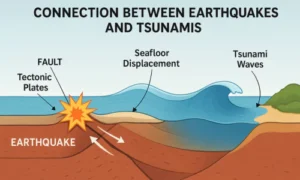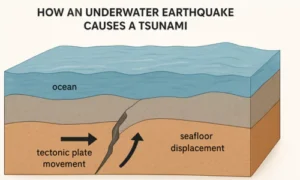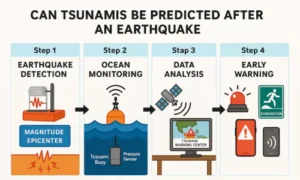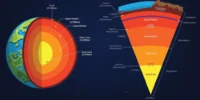When most people think about earthquakes, they envision the ground trembling beneath them. However, when earthquakes strike deep beneath the ocean level, they can release one of nature’s most powerful and deadly forces: a tsunami. Understanding how underwater earthquakes cause tsunamis can help us plan for and respond to these terrible catastrophes.
What is a tsunami?
A tsunami is a succession of huge ocean waves created by the abrupt displacement of a significant volume of water. Unlike typical ocean waves, which are caused by wind, tsunamis are frequently caused by seismic activity beneath the water.

The Connection Between Earthquakes and Tsunamis
Most tsunamis are caused by underwater earthquakes near tectonic plate borders. These borders are areas where the Earth’s plates meet and frequently slide, collide, or move past one another.
When these motions occur beneath the ocean, they can quickly alter the contour of the seafloor, and this is where the trouble begins.
Step-by-Step: How an Underwater Earthquake Causes a Tsunami

1. Seafloor Displacement
When an earthquake occurs beneath the ocean, it can cause a section of the seafloor to suddenly uplift or drop. This vertical movement pushes or pulls the water column above it, creating an initial wave.
2. Energy Transfer
The sudden displacement sends a massive amount of energy into the water. This energy spreads outward in all directions from the epicentre, forming long waves that can travel across entire oceans.
3. Invisible in Deep Water
In deep ocean waters, tsunami waves are often barely noticeable — their wave height can be less than a meter, and they travel at speeds up to 800 km/h (500 mph). Ships at sea may not even feel their passing.
4. Amplification Near Shore
As these waves approach shallower coastal waters, their speed decreases, but their height increases dramatically. This is due to the wave energy being compressed, causing waves to rise into towering walls of water.
5. Coastal Impact
Once the wave reaches the shore, it can surge far inland, destroying buildings, sweeping away people and vehicles, and leaving behind massive devastation.
Famous Examples
- 2004 Indian Ocean Tsunami – Triggered by a magnitude 9.1 earthquake off the coast of Sumatra, it killed over 230,000 people across 14 countries.
- 2011 Japan Tsunami – Caused by a magnitude 9.0 earthquake, it led to widespread destruction and the Fukushima nuclear disaster.
Can Tsunamis Be Predicted After an Earthquake?

While earthquakes cannot be predicted, tsunami warning systems can detect underwater quakes and estimate the potential for a tsunami within minutes. These systems use:
- Seismographs are used to detect earthquakes.
- Buoys to measure sea level changes.
- Communication networks to send alerts to at-risk areas.
Key Takeaways
- Underwater earthquakes cause massive displacements of water, resulting in tsunami waves.
- Tsunamis travel quickly and low in deep water; closer to shore, they slow but grow taller.
- Awareness and early warning systems save lives in tsunami-prone areas.
Conclusion
Underwater earthquakes are one of nature’s most potent tsunami triggers, causing a chain reaction that may spread havoc across entire oceans. Understanding how seismic motions displace water and cause large waves allows us to grasp the value of early warning systems, catastrophe planning, and worldwide cooperation in saving lives. While we cannot prevent earthquakes from occurring, education, attention, and readiness are our best instruments for mitigating the fatal impact of the tsunamis they cause.






